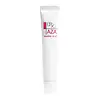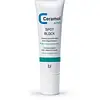Drx Azelaic Acid Versus Ceramol Spot Block
What's inside
What's inside
 Key Ingredients
Key Ingredients

 Benefits
Benefits

 Concerns
Concerns

 Ingredients Side-by-side
Ingredients Side-by-side

Water
Skin ConditioningAzelaic Acid
BufferingButylene Glycol
HumectantTriethylhexanoin
MaskingParaffinum Liquidum
EmollientCaprylic/Capric Triglyceride
MaskingDiglycerin
HumectantPentylene Glycol
Skin ConditioningGlyceryl Stearate
EmollientSimmondsia Chinensis Seed Oil
EmollientPEG-60 Hydrogenated Castor Oil
EmulsifyingNylon-12
Cetearyl Alcohol
EmollientAmmonium Acryloyldimethyltaurate/Vp Copolymer
Hydroxypropyl Methylcellulose Stearoxy Ether
Disodium EDTA
Water, Azelaic Acid, Butylene Glycol, Triethylhexanoin, Paraffinum Liquidum, Caprylic/Capric Triglyceride, Diglycerin, Pentylene Glycol, Glyceryl Stearate, Simmondsia Chinensis Seed Oil, PEG-60 Hydrogenated Castor Oil, Nylon-12, Cetearyl Alcohol, Ammonium Acryloyldimethyltaurate/Vp Copolymer, Hydroxypropyl Methylcellulose Stearoxy Ether, Disodium EDTA
Water
Skin ConditioningAzelaic Acid
BufferingGlycerin
HumectantCI 77891
Cosmetic ColorantPolymethyl Methacrylate
Batyl Alcohol
EmollientStearic Acid
CleansingDicaprylyl Carbonate
EmollientDipentaerythrityl Pentaisononanoate
EmollientPalmitamide Mea
Pentylene Glycol
Skin ConditioningTalc
AbrasiveTriethylhexanoin
MaskingAmmonium Acryloyldimethyltaurate/Vp Copolymer
Azelamidopropyl Dimethyl Amine
AntimicrobialCeramide NP
Skin ConditioningCholesterol
EmollientGlycyrrhetinic Acid
Skin ConditioningHydrogenated Retinol
Skin ConditioningIsopropyl Palmitate
EmollientPhytosphingosine Hcl
Skin ConditioningButylene Glycol
HumectantCaprylic/Capric Triglyceride
MaskingCaprylyl Glycol
EmollientDisodium EDTA
Lecithin
EmollientMica
Cosmetic ColorantPentaerythrityl Tetra-Di-T-Butyl Hydroxyhydrocinnamate
AntioxidantPotassium Cetyl Phosphate
EmulsifyingTin Oxide
AbrasiveUndecylenoyl Glycine
CleansingWater, Azelaic Acid, Glycerin, CI 77891, Polymethyl Methacrylate, Batyl Alcohol, Stearic Acid, Dicaprylyl Carbonate, Dipentaerythrityl Pentaisononanoate, Palmitamide Mea, Pentylene Glycol, Talc, Triethylhexanoin, Ammonium Acryloyldimethyltaurate/Vp Copolymer, Azelamidopropyl Dimethyl Amine, Ceramide NP, Cholesterol, Glycyrrhetinic Acid, Hydrogenated Retinol, Isopropyl Palmitate, Phytosphingosine Hcl, Butylene Glycol, Caprylic/Capric Triglyceride, Caprylyl Glycol, Disodium EDTA, Lecithin, Mica, Pentaerythrityl Tetra-Di-T-Butyl Hydroxyhydrocinnamate, Potassium Cetyl Phosphate, Tin Oxide, Undecylenoyl Glycine
Ingredients Explained
These ingredients are found in both products.
Ingredients higher up in an ingredient list are typically present in a larger amount.
Ammonium Acryloyldimethyltaurate/Vp Copolymer (let's call it AAVC for short) is a synthetically created polymer. It's used as a film-forming agent and used to thicken the consistency of products.
AAVC is able to increase the consistency and viscosity of products due to its large molecule size. It also prevents ingredients from separating.
Azelaic acid is a multitasker ingredient that helps treat acne, pigmentation, and irritation. It is a great option for sensitive skin.
What makes azelaic special?
The best thing about azelaic acid is it's gentleness. It's generally well-tolerated and safe to use alongside other actives like niacinamide or salicylic acid.
Unlike AHAs, azelaic acid will not make you photosensitive/sun sensitive.
You can find this ingredient naturally occurring in grains like wheat, rye, and barley. In cosmetics, azelaic acid is typically lab-made, which is more stable and effective.
Learn more about Azelaic AcidButylene Glycol (or BG) is used within cosmetic products for a few different reasons:
Overall, Butylene Glycol is a safe and well-rounded ingredient that works well with other ingredients.
Though this ingredient works well with most skin types, some people with sensitive skin may experience a reaction such as allergic rashes, closed comedones, or itchiness.
Learn more about Butylene GlycolThis ingredient is an emollient, solvent, and texture enhancer. It is considered a skin-softener by helping the skin prevent moisture loss.
It helps thicken a product's formula and makes it easier to spread by dissolving clumping compounds.
Caprylic Triglyceride is made by combining glycerin with coconut oil, forming a clear liquid.
While there is an assumption Caprylic Triglyceride can clog pores due to it being derived from coconut oil, there is no research supporting this.
Learn more about Caprylic/Capric TriglycerideDisodium EDTA plays a role in making products more stable by aiding other preservatives.
It is a chelating agent, meaning it neutralizes metal ions that may be found in a product.
Disodium EDTA is a salt of edetic acid and is found to be safe in cosmetic ingredients.
Learn more about Disodium EDTAPentylene glycol is typically used within a product to thicken it. It also adds a smooth, soft, and moisturizing feel to the product. It is naturally found in plants such as sugar beets.
The hydrophilic trait of Pentylene Glycol makes it a humectant. As a humectant, Pentylene Glycol helps draw moisture from the air to your skin. This can help keep your skin hydrated.
This property also makes Pentylene Glycol a great texture enhancer. It can also help thicken or stabilize a product.
Pentylene Glycol also acts as a mild preservative and helps to keep a product microbe-free.
Some people may experience mild eye and skin irritation from Pentylene Glycol. We always recommend speaking with a professional about using this ingredient in your routine.
Pentylene Glycol has a low molecular weight and is part of the 1,2-glycol family.
Learn more about Pentylene GlycolTriethylhexanoin is created from glycerin and 2-ethylhexanoic acid. It is a solvent and emollient.
As a solvent, Triethylhexanoin helps dissolve ingredients to stable bases or help evenly distribute ingredients throughout the product.
It is also an emollient and helps condition the skin.
Learn more about TriethylhexanoinWater. It's the most common cosmetic ingredient of all. You'll usually see it at the top of ingredient lists, meaning that it makes up the largest part of the product.
So why is it so popular? Water most often acts as a solvent - this means that it helps dissolve other ingredients into the formulation.
You'll also recognize water as that liquid we all need to stay alive. If you see this, drink a glass of water. Stay hydrated!
Learn more about Water